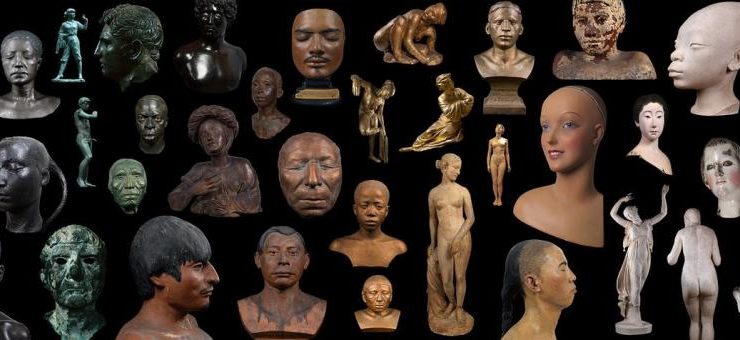
Arranged by Color Photography by Ken Gonzales-Day
September 29, 2021
At first glance, the photographs created by Ken Gonzalez-Day appear to be mere re-presentations of ancient sculpture, similar to that you might see on a museum wall; however, when displayed in massive, bill-board-sized installations throughout Los Angeles, these large photographic compositions take on new meaning. Shown against the context of the diversity of Los Angeles, the collections of artifacts depicted in his Profiled Series highlight the limitations of representational systems and historical constructions of race. In doing so, Gonzalez-Day’s installations allow the viewer to reimagine history and investigate how hierarchies of control are enforced and disrupted.
The Profiled series began while I was a visiting fellow at the Getty Research Institute where I set out to photograph every portrait bust in the collection as a way of thinking about Los Angeles, whiteness, historical memory, and museum display…I hoped my research might help me to better understand how historical models of bias and discrimination continue in resurface in contemporary culture — from police shootings and racial profiling to attitudes about immigration, gender equity, and other aspects of human difference.
The sculptural artifacts’ various imperfections remind viewers of the philosophical, metaphysical, spiritual, legal, and scientific understandings of how time alters social constructions of race. Gonzalez-Day’s works highlight the lives of erased people and remembered people, empowered people and oppressed people; signifying the immense diversity and history of the Greater Los Angeles area while critiquing the larger systemic powers at play. The public artwork displayed at the LAPD Metro Division Facility, for example, was created as an opportunity to re-imagine the department’s past, current, and future relationships with the many communities it serves. This installation included eleven baked enamel images that consider the intersections between beauty and human difference in relation to race. Displaying these works at the police station critiqued the systems and institutions that permit police brutality and acts of racial violence to occur on a daily basis while simultaneously providing a memorial to honor the lives that have been lost to those injustices.

Ken Gonzales-Day, 41 Objects Arranged by Color, Lightjet print on Dibond, 2016. Purchased with funds from the Escalette Endowment.
The photograph in the Escalette Permanent Collection of Art, 41 Objects Arranged by Color, is a scaled down version of one of the Gonzales-Day’s billboard installations. Displayed in Beckman Hall on Chapman’s Orange campus, this artwork follows suit in creating a discourse between concepts of race and the environment that the work is displayed in. Chapman is a majority white university, with only a Black student population of 117 compared to a white student population of almost 4,000. With this immense racial disparity, Black students on campus—as well as other students of color—are perpetually confronted by their marginalization. By exhibiting 41 Objects Arranged by Color, the work becomes a critique of the systems that might impede Black students from thriving on campus. Through its beautiful and unique illustration of diversity, the work takes on the role of representing marginalized students while simultaneously questioning the limitations of those representations.
**The next paragraph contains references to racial violence**
Gonzales-Day’s billboard installations followed a project for which he is most well known, Erased Lynchings Series, which raised awareness of the history of lynching in California by photographing the locations of documented lynchings of African Americans, Asians, Latinxs, Native Americans, and whites in the American west. In these works, Gonzales-Day erases the victims’ bodies in order to draw the viewers’ attention to the jeering crowd. Rather than re-victimizing victims, these works intend to expose the societal systems that permit racial violence.
Sources:
https://kengonzalesday.com/about/
https://www.chapbookmag.com/year-one-done-but-has-anything-changed/
https://www.thepanthernewspaper.org/opinions/opinion-yes-there-really-is-a-problem-at-chapman
https://www.ocregister.com/2021/02/26/why-arent-black-students-thriving-at-chapman-university/
https://www.collegefactual.com/colleges/chapman-university/student-life/diversity/
—
We invite you to explore all the works in the Escalette Collection by visiting our eMuseum.
Wilkinson College of Arts, Humanities, and Social Sciences is the proud home of the Phyllis and Ross Escalette Permanent Collection of Art. The Escalette Collection exists to inspire critical thinking, foster interdisciplinary discovery, and strengthen bonds with the community. Beyond its role in curating art in public spaces, the Escalette is a learning laboratory that offers diverse opportunities for student and engagement and research, and involvement with the wider community. The collection is free and open to the public to view.


